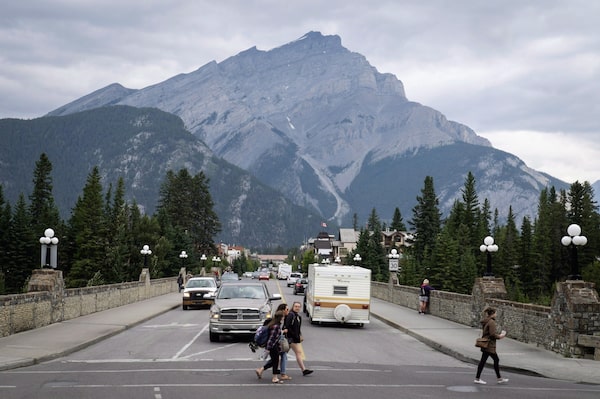
People walk across a street in Banff, Alta., on July 21, 2017.Jeff McIntosh/The Canadian Press
Banff National Park, the oldest and most recognizable of the country’s 47 national parks, is busy. Roughly 8.3 million vehicles reach the park gates each year, up 30 per cent in a decade. Roughly four million of these visitors stop in the park, with 80 per cent of those visiting the towns of Banff, Lake Louise, or both. Parking lots are full, roadside pullovers are at capacity.
And so Parks Canada has, for the first time in its management plan for Banff National Park, sketched out a strategy to ease this pressure. The targets mesh with Parks Canada’s goal to manage the country’s parks through the lens of climate change, another feature new to its management plans.
But the management plan, as well as organizations that work to protect natural landscapes and wildlife, highlight the difficulty in creating a successful transportation strategy in Banff National Park and other sensitive areas. Mass transit, for example, may remove vehicles from the road and reduce greenhouse gas emissions, but an influx of people in the park may mean greater risk to vegetation and animals.
A transportation plan needs to be accompanied by a strategy governing how people use the park once they arrive, according to Sarah Elmeligi, the national parks co-ordinator of the Canadian Parks and Wilderness Society’s chapter in Southern Alberta. While the towns of Banff, Lake Louise and the Lake Minnewanka area are traffic hot spots, the federal government must recognize other parts of the landscape are under pressure, she said.
“We are dealing with a different national park now than the one that we had 10 years ago and the one that we had 10 years before that,” she said. “We need to recognize that human use across the entire park has increased, not just in these extremely busy areas.”
Environmental groups raise concerns about proposed Calgary-to-Banff passenger train
By law, roughly 97 per cent of the park is designated as wilderness. Parks Canada has convened an expert panel to advise it on how to proceed with moving people in a sustainable manner.
The management plan flagged the Lake Minnewanka area as one of the park’s most popular destinations, with about one million people visiting annually. It noted day-use areas and picnic shelters at Cascade Ponds, Johnson Lake Reservoir, Two Jack Lake and Lake Minnewanka Reservoir are the busiest in the park, and the Two Jack Lakeside and Two Jack Main campgrounds are fully occupied throughout the summer.
Public transit alone cannot alleviate the pressure on popular areas of the park, the report noted.
“The high number of visitor facilities in a relatively small area are not well-linked by trails. As a result, despite the introduction of public transit to the area in recent years, most users tend to arrive at and move around the area by personal vehicle,” Parks Canada said of the Lake Minnewanka area, pointing to the need for better ”wayfinding and orientation signage.”
Traffic volume in the area, the report said, increased by about 50 per cent over the past decade, with 75 per cent of that occurring between May and the end of September.
The management plan also noted that building transportation infrastructure, such as roads and parking to meet demand, comes at the cost of wildlife habitat or spots of cultural significant. Additional road and parking capacity can also encourage more car use, increasing congestion and greenhouse gas emissions, the report said.
Reg Bunyan, a spokesman for Bow Valley Naturalists, noted mass transit in the park could “significantly increase” visitors, he said.
“What Parks Canada got right was the idea of a scalable and flexible transit system, but what they’ve failed to do is plan for some form of limits, to avoid mass transit adding significantly more visitors to an already impacted landscape,” he said.
Parks Canada unveils climate change and traffic congestion targets for mountain destinations
Jan Waterous, the managing partner of Liricon Capital Ltd., which is pushing for a passenger train connecting Calgary to Banff, does not share concerns over the growing number of visitors to the park.
“It is not that Banff National Park has too many people,” she said. “It is that we have too many personal vehicles.”
Parks Canada’s management plan made a brief reference to the proposed passenger train, tying rail traffic to animal deaths.
“While wildlife mortality from vehicle strikes on the Trans-Canada Highway has been somewhat mitigated through Banff’s renowned system of crossing structures and fencing, and collaborative work with CP Rail on mitigating wildlife mortality train strikes continues, there is still much work to be done,” the management plan said. “Proposals for twinning the rail line for passenger rail between Calgary and the community of Banff, and for expansion of the rail sidings in the park may, if they come to fruition during the life of this plan, augment these challenges.”
This, Ms. Waterous said, is the first time Parks Canada has officially acknowledged the train proposal. She is not deterred by Parks Canada noting expanded rail traffic would augment the challenge of protecting wildlife from moving trains. Instead, she argued, Parks Canada recognized its role in shielding animals from harm.
We have a weekly Western Canada newsletter written by our B.C. and Alberta bureau chiefs, providing a comprehensive package of the news you need to know about the region and its place in the issues facing Canada. Sign up today.